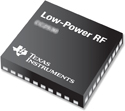Low-energy Bluetooth is formally adopted
Jul 6, 2010 — by LinuxDevices Staff — from the LinuxDevices Archive — 1 viewsThe Bluetooth SIG (special interest group) announced “formal adoption” of Bluetooth 4.0, which includes a new LE (low-energy) mode. Allowing devices to operate for more than a year on button batteries, the spec will let controllers wake host devices within three milliseconds and transfer data at 1Mbps, the organization says.
First announced last December, Bluetooth 4.0 incorporates a low-energy mode that's touted as allowing devices powered by single "button cell" batteries to operate for more than a year without recharging. A descendant of Wibree, first mooted by Nokia in 2006, the technology will be suitable for devices such as watches, wireless keyboards, heart-rate monitors, and even training shoes, the Bluetooth SIG says.
 Even in advance of the December announcement, chipmakers were jumping on the Bluetooth 4.0 bandwagon. The previous month, for example, Texas Instruments (TI) had announced what it said was the "world's first single-chip, single-mode Bluetooth low energy device" in the form of the CC2540 SoC (right and below).
Even in advance of the December announcement, chipmakers were jumping on the Bluetooth 4.0 bandwagon. The previous month, for example, Texas Instruments (TI) had announced what it said was the "world's first single-chip, single-mode Bluetooth low energy device" in the form of the CC2540 SoC (right and below).
A demonstration of Bluetooth low energy
Source: Texas Instruments
(click to play)
Single-mode chips such as the TI part will be destined for highly integrated, compact devices that use a minimum of power. Meanwhile, it's said, current Bluetooth chips will be able to talk to such devices once they have been equipped with a new low-energy software stack.
According to the Bluetooth SIG, interoperability testing of Bluetooth 4.0 devices will be performed this October in Barcelona at an event known as UnPlugFest (UPF) 37. The technology should be available to users by the end of the year, the organization added.
Michael Foley, executive director of the Bluetooth SIG, stated, "The finalization of Bluetooth low-energy wireless technology within the core specification is a monumental achievement. Bluetooth wireless technology can now, with the hard work of our members and our world-class qualification program, really do it all."
West Technology Research Solutions analyst Kirsten West, quoted by our sister publication eWEEK, said "Bluetooth low energy will be a significant contributor to the overall wireless sensor network market, representing nearly half of all shipments in 2015. The advantage to this new protocol is that it is totally optimized for low power battery operation."
Background
According to the Bluetooth SIG, low-energy devices will operate in the same 2.4GHz ISM (industrial, scientific, and medical) band as today's Bluetooth equipment and, once again, will be able to operate over distances of up to 100 meters (about 300 feet). Controllers will include "a significant amount of intelligence," allowing a host device to be awakened only when it needs to perform some action, the group adds.
It's said Bluetooth low-energy technology will allow an application to form a connection and then transfer data within as little as three milliseconds. Operating at 1Mbps, Bluetooth 4.0 supports very short data packets (8 octet minimum up to 27 octets maximum), and employs "advanced sniff-subrating to achieve ultra low duty cycles," the SIG adds.
Because Bluetooth low-energy tech uses a 32-bit access address on every packet for each slave, it allows billions of devices to be connected, according to the group. While being optimized for one-to-one communications, it also allows one-to-many connections via a star topology, and — thanks to the use of quick connections and disconnections — can move data in a mesh-like topology without the complexities of maintaining a mesh network, the SIG further claims.
The addition of a low-energy mode in Bluetooth 4.0 follows last year's approval of Bluetooth 3.0, which is just now rolling out in netbooks, phones, and other devices. Also known as AMP (alternate MAC/PHY) Bluetooth, Bluetooth 3.0 targets devices that have both Bluetooth and WiFi (802.11) radios on board.
According to the Bluetooth SIG, AMP works by taking Bluetooth's protocols, profiles, security, and other architectural elements and allowing them to "jump on top of an already present 802.11 radio." In other words, a pair of devices discover each other and shake hands using Bluetooth, but file transfers take place using the WiFi hardware layer at up to 24Mps.
Bluetooth 3.0's promoters say the technology means users gain speed, without needing to know how to set up an ad hoc WiFi network. Once a file transfer is concluded, the WiFi radio falls silent and control passes back to Bluetooth, saving power, according to the SIG.
Based in Kirkland, Washington, the Bluetooth SIG includes "promoter" member companies Ericsson, Intel, Lenovo, Microsoft, Motorola, Nokia, and Toshiba, as well as more than 13,000 "associate" and "adopter" members. The group says nearly three billion Bluetooth devices are on the market, more than 19 million units ship per week, and eight new products are qualified every working day.
Further information
Further information about Bluetooth 4.0 should be available from Bluetooth.com, here, though the site was down at the time of writing. The SIG also provides info at Bluetooth.org, here, but use of the latter site appears to be restricted to SIG members, requiring a password.
eWEEK's coverage of Bluetooth 4.0 may be found on the publication's website, here.
This article was originally published on LinuxDevices.com and has been donated to the open source community by QuinStreet Inc. Please visit LinuxToday.com for up-to-date news and articles about Linux and open source.